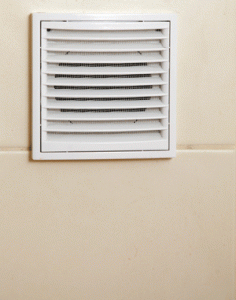
Accumulated condensation and moisture create a perfect environment for mold and mildew growth. But water vapor that happens in the bathroom doesn’t stay in the bathroom. Often, it infiltrates walls or upwards into the attic or upstairs rooms, bringing damaging moisture wherever it goes. Migrating bathroom humidity also makes the house harder to cool and causes the air conditioner to run longer. The antidote to excessive humidity is making sure the bathroom is properly ventilated.
What Kind Of Ventilation?
One-way exhaust fans are usually installed in bathrooms, allowing fresh air drawn from the rest of the house to make up for the humid exhausted air. Most bathroom exhaust fans are installed in the ceiling and connect to a dedicated duct that conveys the air all the way to the exterior of the house. In some cases, fans may be installed in the bathroom wall and exhaust directly through the exterior wall to the outdoors. Bathrooms fans should never exhaust into the attic—moisture accumulation in the attic can be very damaging.
How Much Ventilation?
In bathrooms measuring 100 square feet or less, the exhaust fan should generate one cubic foot per minute (CFM) of exhaust air to adequately remove humid air. This exhausts the entire volume of air in the bathroom about eight times per hour.
How Long To Ventilate?
Bathroom exhaust fans should run for 20 minutes after each use of the bathroom. To avoid under-ventilating—or excessive energy use by leaving the fan running too long—the fan can be activated by a timer switch instead of a standard on/off control.
Ask the air quality professionals at Ace Hardware Home Services for more details about maintaining proper bathroom ventilation.
Our goal is to help educate our customers in Dayton, Ohio about energy and home comfort issues (specific to HVAC systems).
Credit/Copyright Attribution: “Voyagerix/Shutterstock”







